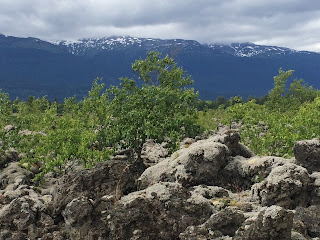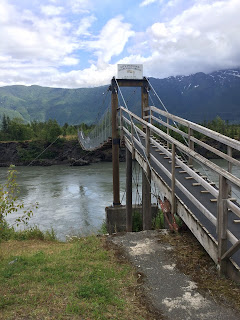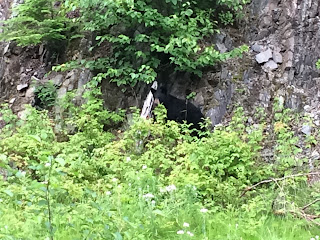Day 59 - Sunday July 16/17
(Posted Friday July 21st in Whitehorse as we sit in McDonalds for several hours while the truck is in at the dealership for servicing after more than 13,500 km of travel!!)
Having changed our plans and departed from our itinerary yesterday, today was our day to go to see the lava-flow bed at the “Nisga’a Memorial Lava Bed Park” in the Nass River Valley. Little did we know the delightful adventure which would unfold - we went to see a lava bed, and discovered a people!(map)
Our departure was delayed as we determined that we would like to secure a campsite with electrical hookup, if possible. To do so, we had to wait until the Camp Operators posted the reservations and vacancies on the site posts, at about 10am. We had bacon, eggs, toast and coffee for breakfast, and also made up pasta salad and coleslaw to have with ham chunks and cheese for our picnic lunch. While Nancy washed up a couple of days worth of dishes and tidied up in the trailer, Michael hiked off to see if a site was available.
It turned out that there was a good one on the lakeshore available - although for one night only - but we decided to move the trailer and know that we had the electricity-serviced site at least for the one night. By the time we moved the trailer and got it set up on the new site, and then chopped vegetables and set up the crock pot with turkey breast and chicken thighs for a one-pot supper to cook while we were out, it was after 12 noon. We finally got on the road at about 12:40, in sunny, 16 degree weather.
We travelled about 60 km back down Hwy 37, looking for a good lunch spot. Finally we found a Provincial ‘Recreation Area’ at Bonus Lake, where we had our picnic. We realized at the last moment that we had forgotten to pack forks or plates for our summer salad lunch, but a rummage through the cooler bag uncovered two plastic forks, and we used the lids of the plastic food tubs for plates - so problem solved!
Back on the road after lunch, we went only about 2 km to the turn-off at Cranberry Junction for the ‘Forest Service Road’ (called "LOGGING ROAD" on the map above) southwest to New Aiyansh where the Lava Bed Park is located. The road was unpaved and unserviced, and very pot-holed. Maximum speed was 60 km/hr, but more often between 5 to 15! The 60 km trip took about 1&1/2 hours!
About half-way, we saw a sign indicating that we were entering Nisga’a Lands. We did not realize the significance of this until somewhat later. (photo)
Just past New Ayansh - now called ‘Gitlaxt’aamiks in the Nisga’a language - we entered the lava-flow bed. What an eerie landscape! (photos)

A few kilometres later we came to the entrance to the Nisga’a Lava Bed Memorial Park, and we followed the signs to the Visitor Centre. There we found a number of information panels describing the origins of the lava bed and its impact on the geology and the indigenous people of the area, the Nisga’a. The lava came from a volcano that erupted in 1750, Canada’s last volcanic eruption. We also met Steve, the person on duty at the Visitor Centre. Steve and the Visitor Centre displays provided a wealth of information, and helped us to realize that this Park is jointly managed by the Nisga’a Nation and BC Parks - the first of its kind in BC. Steve explained that it is the Nisga’a “MEMORIAL” Lava bed Park in honour of the more than 2,000 Nisga’a people who died when the flowing lava destroyed two Nisga’a villages in the Nass Valley.
 We also were made aware that the Nisga’a people had resided in the Nass Valley for over 6,000 years, and of the history of the Nisga’a Nation’s 113 year negotiation with the Canadian Government, which resulted in the Final Agreement in the year 2000: “Unique among Canada’s Aboriginal peoples, we are self-governing - our modern treaty with Canada and British Columbia has allowed us to assume control over the governance of ourselves and our own lands.” “Sayt-K’ilim-Goot”: one heart, one path, one nation - Our Ayuuk(ancient code), language and culture are the foundation of our identity.
We also were made aware that the Nisga’a people had resided in the Nass Valley for over 6,000 years, and of the history of the Nisga’a Nation’s 113 year negotiation with the Canadian Government, which resulted in the Final Agreement in the year 2000: “Unique among Canada’s Aboriginal peoples, we are self-governing - our modern treaty with Canada and British Columbia has allowed us to assume control over the governance of ourselves and our own lands.” “Sayt-K’ilim-Goot”: one heart, one path, one nation - Our Ayuuk(ancient code), language and culture are the foundation of our identity.
(One wonders if this process, negotiation, final agreement, and respect for land rights, should perhaps not be a model for the continued resolution of relations with other indigenous peoples, regardless of historic treaties [which were often entered into unscrupulously by the representatives of the Crown in Canada!], in order to further ‘Truth and Reconciliation’).
While we were at the Visitor Centre, another traveller stopped by and extolled the benefits and value of visiting the Nisga’a Museum, some 40 minutes drive away. Although we had thought to not go there, as it was quite late in the day, we changed our minds and headed off.
We first stopped at the village of ‘Gitwinksihlkw’ (the place of lizards - according to oral tradition, large lizards lived here before the volcanic eruption), where we drove over the vehicle bridge with 4 totem poles of the four Nisga’a clans (photos),
and then went to the old suspension foot bridge (photos).

From the middle of the suspension bridge the extent of the lava bed was clearly visible. A deposit 35 feet in depth! The eruption not only buried the land in rock but pushed the Nass River to the opposite side of the valley.
 |
| The lava bed on one side of the Nass River |
 |
| The bedrock on the other side of the Nass River |
We then went on the the Museum in the village of Laxgalts’ap (‘village on village’ - many successive villages built on the same site). This is a “Class A” Museum, opened in 2011, which houses a collection of over 600 Nisga’a artifacts. These artifacts had been removed during the period of contact with Europeans, and have been repatriated to the Nisga’a people. It was a fabulous exhibit; and the museum staff, two students, were most helpful in explaining many things to us. One staff person even stayed 15 minutes after closing time so that we had more time to explore!
We headed back to our campsite at about 6:30. We had thought to go back via the paved highway to Terrace, but realized that this would be an almost 4-hour trip! So, we braved the Forest Service Road again, and with Nancy’s adept driving got home by 9:30 rather than 10:30.
A delightful surprise to see a black bear alongside the road:
We had a fabulous late supper of chicken and veg that had cooked all afternoon in the crock pot, and got to bed by about 11.
What a learning experience it has been for us to discover so much about the Northwest Coast indigenous peoples - the Gitksan, the Haida, and the Nisga’a - over the last 10 days. We feel in awe of their culture, their art, their values and their friendliness. Our lives have been enriched.














No comments:
Post a Comment